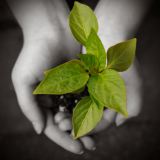The Kurukh's Friend, Chapter 1A - Visitor's Novel
by Ratan Lal Basu
(Kolkata, India)

The giant mango tree stood aloft like a majestic monarch towering above the bushes and other trees in the marshy land that spread undulating between the Rosemary tea garden and the Baikunthapur forest. At sunny noon its lofty widespread branches shaded the centre of the land like an enormous umbrella sheltering the thickets and bushes of akchhatti, dheki-fern, kukurshoka, datura and host of other herbs and wild plants from the sweltering summer heat.
In winter the mire glistened with multi-colored flowers of phutki, jarul and wild creepers and the orchids swaying from the branches of the trees and in the evening, the air was suffused with the fragrance of bhati, golokchapa and shetkutchi; the air reverberated with chatters, squawks, clucks and screeches of migratory birds â black-naked cranes, teals, francolins, goosanders, partridges, ibis bills, fork-tails, wag-tails, red-stars, pelicans and innumerable small birds. In summer, the glade went alive with buzzing of fleas and insects, and melodious songs of cuckoos, parakeets, popinjays, and ear splitting caws of crows and shrill shrieks of peacocks.
When the large ripe mangoes dropped down from the lofty branches, Madeshia and Rajbonshi children, women and men jostled and hustled battering down the bushes at the bottom of the tree.
The burrows and ground holes sheltered variegated rodents and their foes the venomous vipers, mongooses, ichneumons, jackals, wild rabbits, foxes, porcupines, jungle cats, leopard cats and civets. During rains water stagnated in lowly ditches, the frogs played their joyous songs, the ditches and lowlands bristled with magur, punti, kai, singi, sol and many other fishes and the cormorants and herons got busy with fishing and the white and red water lilies greeted the moon at night.
In the deep forest to the north and north-west lived elephants, Bengal tigers, leopards, wild buffaloes, gaurs (a kind of large bison), dholes (wild dogs), monkeys, wild boars, antelopes, barking deer, musk deer, chital, nilgais and various other types of deer, king cobras and pythons. The wild animals except the elephants and monkeys lived in deep forest and rarely came out to the marsh, tea garden or villages.
Before the onset of monsoons at times, stormy winds lashed the glade mercilessly uprooting many trees but the giant tree fought off the demon heroically swaying its bushy head and not a single branch could be broken by the cyclonic winds.
The monarch stood defiantly dwarfing all the trees around and could be visible from the nearest railway station at a distance of three miles. During the Second World War, an American journalist saw the giant tree from the train while traveling from Haldibari to Siliguri and mistook it to be an Indian Redwood tree.
The giant tree was there from ages and from whence no body could tell. The oldest man, the nonagenerian Palisanju Roy had seen the tree the same during his childhood and the tea garden records mention the tree at the time of buying the land that included this marsh.
The local legend about the tree is interesting. Baikunthanath Lord Krishna built a palace for his wife Rukmini at the forest and named it Baikunthapur, to avert her quarrel with Radhika (goddess Lakshmi). To the south-eastern end of the forest goddess Parvati lived under the name of Bhramori and to further east lived Lord Shiva in the name of Jalpeswar (the god of warm clothes). They fell in love and married at Cho Lhamu hills. According to marriage ritual Parvati washed the hands of Shiva and the water created a vast river Kartowa (Kar = hand, towa = water).
Later on, tectonic upheavals split up the main river into three major branches. The easternmost main flow is known as Tista, the middle course is known as Kartowa-Atri and the westernmost known as Mahananda-Punarbhaba. Besides there are innumerable smaller flows separated by land fault. Among them Jatadha, Dharla, Buri-tista, Panga and Karola are tributaries of Tista; Talma, Chawai, Shau-Dahuk and Phuleswari are tributaries of Kartowa; and Punarbhaba, Tangon, Nagar, Kulik, Balason and Mechi are tributaries of Mahananda.
Krishna invited the newly wedded couple to his palace at Baikunthapur and the couple agreed that they would visit his palace under the names of Pashupati (god of the wild beasts) and Saleswari (goddess of the sal trees) respectively. Narada, the singer and comedian sage of heaven, informed all the gods about the sacred visit to Krishnaâs palace. Indra, the king of the gods, offered Krishna the best flower Indra-kamal (Magnolia Grandiflora) and Surya, the sun god, the best fruit, Suryapuri mango, for entertaining the guests. Shiva and Parvati relished the mangoes with great pleasure and threw out the seeds into the marshy ground. Later on the mango tree grew from one of the seeds thrown out by them.
Click here to post comments.
Return to Visitors' Stories and Poems.
The Kurukh's Friend, Chapter 1B - Visitor's Novel
by Ratan Lal Basu
(Kolkata, India)

While the tea garden was established during the 1870s, the tree was still there. William Flintwood, the founder, owned a large farmhouse near London. His young beautiful wife, whom he called Rose-Mary because of her beauty, died of tuberculosis in 1870. This frustrated the young landlord who wanted to leave the country and do some business in a far off country. So he sold out the estate and bought thousand acres of tea-garden land in the Cachar district of Assam, India from a broker.
He requested his friend, manager of a tea estate of Williamson Magor & Company in Assam, to enquire into the condition of the tea-garden land. The latter replied that no such land exists in reality but he need not worry as their company too had the same experience. Itâs a gross irregularity on the part of the land department of the India Government to grant tea estate lands to brokers without verifying whether the land exists in reality or not. So, if he pressurizes, the land department, to cover up the irregularity, would grant him any vacant land he chooses for the desired tea garden.
William was very much upset as he did not know which land to claim in India, the country he had no idea about, and he thought his money being lost. But fortunately at a seminar, he happened to come upon the great scientist Dalton Hooker who suggested him to claim land near Siliguri of northern Bengal to the west of the Chawai river adjacent to the Baikunthapur forest. The soil of the grassy undulating land is appropriate for cultivation of Camellia Assamica and the land could be well irrigated by channels from the large horse-shoe lake left by the change of course of the Chawai.
So William went to Calcutta and the India Government accepted his proposal and officials accompanied him on elephant from Siliguri to the land. Over and above the thousand acres of high land, the government also granted him the adjacent marshy land bounded by the horse-shoe lake and the dense forest.
It took a few years to prepare the land, plant tea saplings and found the factory. The estate was named after his wife âRose-Maryâ and production started by late 1870s. It was highly profitable, but William did not find any peace of mind. So he sold the garden to a managing agency house, donated all his money to a poor-fund and left for Tibet with a Lama in quest of peace.
The local Rajbonshis and the Madeshia plantation laborers held the mango tree sacred. Rajbonshis considered it a monument of the meetings of Lord Krisna, Shiva and Parvati and Madesias considered it as the tree planted by Singbonga, Marangburu and Dharmesh. There were expert tree-climbers, who could climb the vast tree easily and pluck ripe mangoes, but they dared not incur displeasure of the gods by such inadvertence and therefore, everybody remained satisfied with the ripe mangoes dropped down from the tree. Local people also collected pot vegetables like dheki-fern, noteshak, aquatic kolmishak, kundru and also herbs like thankuni, satamuli, mutha-grass and kendra-grass. They also picked tamarind, chalta, blackberry and various other fruits from the smaller trees.
Boys and girls of the locality used to collect offspring of birds like mainas, cuckoos (from nests of crows), doves, shaliks, parrots and parakeets. Monkeys at times feasted on the ripe fruits of the trees. Once, a baby monkey fell down from her motherâs lap. Maghu, a young Muslim boy, who was cycling by the road picked up the cub, and raced away as the troupes of monkeys chased him to a long distance.
Later on he sold it to a land lordâs son and the monkey was well known as Maghuâs monkey. Some birds used to lay eggs in holes of the trees and the young boys and girls collected offspring from these holes. Sima, a Rajbonshi girl, was weaving a kantha sitting near the field. She saw a hole at the trunk of an adjacent tree and while she entered her hand into the hole with the hope of picking up bird offspring she was snapped by a cobra. She had quick wit to bind her hand above the bite tightly with the hard cotton fabric from which she was drawing threads. She fainted after returning home and the local people cut the place below the binding and let the poisoned blood seep out.
Later on the local doctor burnt the spot with potassium permanganate. Her life was saved but she became anemic since then.
The unmetalled road, that separated the tea shrubs from the marsh, branched out into the small villages of the Rajbonshi peasants and paddy fields and through the forest towards Siliguri town. At the corner of the road close to the marsh were small temples, made by bamboo wattles and roofed with tin or straw, of various gods, goddesses and grotesque apparitions. The Ganesh temple was the largest and was roofed by corrugated tin on wooden structure. There were large flat vessels of burnt earth in front of the temple. They were filled with haria offered to the elephant god but virtually guzzled by the elephants that happened to cross over from the forests. It was a treat to watch the mastodons wobbling along after drinking the rice fermented liquor. These elephants, residing in the border of the forest, were addicted to haria and sufficient haria should be kept in the vessels at specific times. Otherwise the elephants would invade the locality damaging houses and killing people.
Click here to post comments.
Return to Visitors' Stories and Poems.
|





 Inspirational Quotes
Inspirational Quotes
